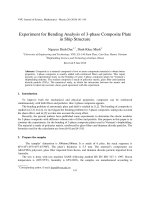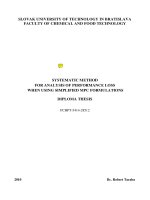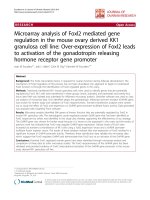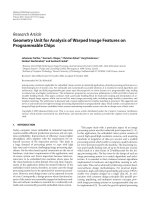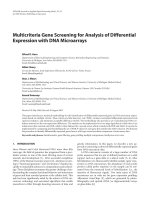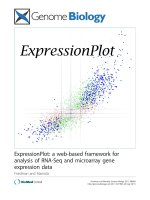Applied bioinformatics tools for analysis of microrna-214 expression and prediction of its potential targets genes in nasopharyngeal carcinoma
Bạn đang xem bản rút gọn của tài liệu. Xem và tải ngay bản đầy đủ của tài liệu tại đây (468.99 KB, 10 trang )
Nguyen Hoang Danh et al. Journal of Science Ho Chi Minh City Open University, 9(2), 3-12
3
APPLIED BIOINFORMATICS TOOLS FOR ANALYSIS
OF MICRORNA-214 EXPRESSION AND PREDICTION
OF ITS POTENTIAL TARGETS GENES IN
NASOPHARYNGEAL CARCINOMA
NGUYEN HOANG DANH1, THIEU HONG HUE2, QUANG TRONG MINH1,
K’ TRONG NGHIA1, NGUYEN THANH TUNG1, PHAN DANG HOANG NAM1,
TRAN HOANG BAO TRAN1, LAO DUC THUAN1,2,*
1
2
Ho Chi Minh City Open University, Vietnam.
University of Science, Vietnam National University Ho Chi Minh City, Vietnam
*Corresponding author:
(Received: April 17, 2019; Revised: May 08, 2019; Accepted: May 21, 2019)
ABSTRACT
miRNA (microRNA) are short RNA molecules in length from 20 to 24 nucleotides that have
been shown to play an important role in regulating gene expression in many different types of
human cancer. Meanwhile, miRNA-214 is one of the known miRNAs involved in the formation
of nasopharyngeal carcinoma (NPC) through overexpression that promotes proliferation and
development of cancer cells. However, in Vietnam, the study of miR-214 related to NPC has not
been conducted yet. With the aims to develop the further studies of miR-214 on NPC in
Vietnamese patients, in this initial study, we conducted the analysis of miR-214 expression in
previous publications, as well as the prediction of miR-214 potential target genes, which involved
in many cellular pathways. Here we applied bioinformatics tools to predict miRNAs and their
targets, and discuss the role of miR-214 in the context of human cancers. As the results, miR-214
acted as the oncogenic roles in NPC, relevanted to many pathways, such as cell proliferation,
apoptosis, metastasis and invasion through the its target genes LTF, Bim, Bax, LINC0086, etc. In
conclusion, the use of computional approaches facilitate the further experimental validation of
miRNAs in general, particularly miR-214, in Vietnamese NPC patients.
Keywords: MicroRNA; MiRNA-214; Nasopharyngeal carcinoma.
1. Introduction
Nasopharyngeal carcinoma (NPC), a
malignant
tumor
arising
from
the
nasopharyngeal epithelium, has pronounced
differences in distribution according to
geography and ancestry, is the fifth most
common cancer worldwide (Khoo & Pua,
2013). Growing evidences indicated that
miRNAs have been implicated as both
oncogenes and tumor suppressors that the
abnormal expression (positive up-regulation
or down-regulation) of miRNAs contributes to
various human tumor pathogenesis through
interacting with its target genes. Many
previous studies reported that the abnormal
expression of miRNAs could be served as the
potential biomarkers for the diagnosis and
therapy of human cancer (Lan et al., 2015;
4
Nguyen Hoang Danh et al. Journal of Science Ho Chi Minh City Open University, 9(2), 3-12
Yuan et al., 2018). Among them, miR-214 has
been reported to be aberrant expressed in
many human cancers, including NPC.
However, numerous studies have shown the
conflicting results regarding to whether the
role of miRNA is an oncogenic miRNA or
tumor suppressor miRNA in NPC. On the
other hand, the prediction of its target gene,
for which the target gene acts as an oncogene
or a tumor suppressor gene, combined to miR214, give a hand for development of the novel
molecular target diagnosis and treatments.
In Vietnam, the study of miRNAs, in
particularly miR-214 on NPC has not been
studied yet. In order to build a scientific basis
for experimental early detection and prognosis
of NPC based on the identification of
miRNAs expression, specifically miR-214,
we conducted: the systematic revision of miR214, based on the previous publications, in
NPC, to determine the miR-214 roles in NPC.
Moreover, the prediction of its potential target
genes, which relevant to NPC tumorigenesis
pathways, was performed by the application
of bioinformatics tools, such as TargetScan
7.2, DAVID 2008 Functional Annotation
Bioinformatics Microarray Analysis Tools,
etc. This initial study will play a role in
building the foundation for the development
of the following research direction related to
miRNAs in general and effect of miR-214 to
the formation and development of NPC in the
Vietnamese population.
2. Material and method
2.1. Data collection
Several keywords, such as “microRNA214”, “nasopharyngeal carcinoma”, etc., were
applied to retrieve the information of miR-214
by collected the previous publications on many
databases, included PubMed, Embase, Web of
Science databases, Embase Database, etc. The
studies fulfilling the following criteria were
included in the systematic review. Inclusion
criteria: [1] Case-control study or cohort study
that published the miRNA-214 expression
profile, and clinicopathological feature. [2]
Studies that investigated expression of miRNAs
in NPC. [3] Study that mention detection,
analysis method of miRNA-214 expression.
2.2. MicroRNA targets prediction bioinformatic
The miRBase database
( was used for
finding out the basic information of miR-214.
Possible target genes and signal pathways
were
validated
by
utilizing
Pictar
( TargetScan 7.2
( />and
miRDB ( which identifies
binding
sites
targeted
by
single
miRNA.DAVID 2008 Functional Annotation
Bioinformatics Microarray Analysis Tools
( was used to
classify the functions of the target genes,
which were predicted from Pictar, TargetScan
7.2 and miRDB online softwares.
3. Results
3.1. Location, sequence of miRNA-214
miR-214 is located at 1q.24.3 (nt: 172138798
- 172138907, [-]), is the same location
with the miRNA-3120. However, the length
of miRNA-3120 is shorter than miR-214,
therefore, miR-3120 is located inside the
gene of miRNA-214. According to miRNA
Database, the precusor-miRNA-214, which is
further cleaved by the cytoplasmic Dicer
ribonuclease to generate the two sequences,
terms hsa-miR-214-5p (hsa-miR-214*) and
hsa-miR-214-3p (hsa-miR-214) (Fig. 1).
Nguyen Hoang Danh et al. Journal of Science Ho Chi Minh City Open University, 9(2), 3-12
5
Figure 1. Location of miR-214. Mature-hsa-miRNA-214-5p is red sequence, mature-hsamiRNA-214-3p is blue sequence.
Figure 2. Sequences of the three member of miRNA-214/761/3619-5p family (miR-3619-5p,
miR-214-3p, miR-761).
MiRNA-214 is belonged to the miRNA214/761/3619-5p family. The miRNA214/761/3619-5p family includes three
members (miRNA-214-3p, miRNA-761 and
miRNA-3619-5p), which classified based on
the sequence homology in their seed regions
“CAGCAGG” (Fig. 2). The seed region of
mature miRNAs bound to 3’UTRs on target
mRNA with complete or incomplete
matching. The binding between miRNA and
its target mRNA through the seed region leads
to the degradation of mRNA or the blocking
of mRNA translation (Filipowicz et al., 2008).
When comparing the human pre-miRNA214 with pre-miRNA-214 of 22 different species
showed highly conserved in the sequences.
As the result, both mature-miRNA-214-5p
(miRNA-214*) and mature-miRNA-214-3p
(miRNA-214) are conserved in many species,
have conserved sequence: GCCUGUCU/UCA
CUUGCUGUGC and ACAGCAGGCACAGA
CAGGCAG, respectively (Fig. 3).
6
Nguyen Hoang Danh et al. Journal of Science Ho Chi Minh City Open University, 9(2), 3-12
Figure 3. The highly conserved nucleotides of miR-214 are is observed in many species. MiR214 precusor sequences of 22 species were downloaded and aligned by BioEdit software. The
star (*) represents nucleotieds are similar in all species (hsa: Homo sapiens; ami: Alligator
mississippiensis; cli: Columba livia; pbv: Python bivittatus; gmo: Gadus morhua; xla: Xenopus
laevis; cpo: Cavia porcellus; dno: Dasypus novemcinctus; ocu: Oryctolagus cuniculus; pal:
Pteropus alecto; tgu: Taeniopygia guttata; aca: Anolis carolinensis; cgr: Cricetulus griseus; ssa:
Salmo salar; chi: Capra hircus; cpi: Chrysemys picta; mmu: Mus musculus; rno: Rattus
norvegicus; ssc: Sus scrofa; mml: Macaca mulatta; mdo: Monodelphis domestica; oan:
Ornithorhynchus anatinus).
3.2. The expression of miRNA-214 in
NPC
Up to April, 2019, the total of seven
publications, included Case – Control study
and Cohort study, related to the expression of
miR-214 in NPC was shown in Table 1. The
results of those studies showed that miR-214
affected different target genes involved in
several signal pathways: signaling pathways in
cell, such as cell proliferation, apoptosis, etc.
Table 1
A concise overview of previous studies related to miR-214 in NPC
Study
Deng et al.
Year Country Assay
2013
Plieskatt et al. 2014
China4
United
Stage
qRTPCR
qRTPCR
Type of study/
Sample
Expression /
Target of miR-214
Case - control
Up-expression in NPC patient
Case: 27 NPC biopsy.
→ Oncogenic miR-214.
Control: 10 normal
miR-214 regulated signal
nasopharyngeal
pathway LTF/AKT.
epithelial tissues.
Case – control
Case: 4 FFPE tissue
and 54 serum from
NPC patients
Control: 12 noncancerous FFPE
tissue and 26 noncancerous serum
Down-expression in NPC
patient → Tumor suppressor
miR-214.
Nguyen Hoang Danh et al. Journal of Science Ho Chi Minh City Open University, 9(2), 3-12
Study
Zhang et al.
Lu et al.
He et al.
Li et al.
Guo et al.
Year Country Assay
2014
2014
2015
2016
2017
China
China
China
China
China
qRTPCR
and
FISH
Type of study/
Sample
7
Expression /
Target of miR-214
Case - control
Up-expression in NPC patient
→ Oncogenic miR-214.
Case: 5 NPC biopsy.
miR-214 regulated signal
Control: 5 adjacent
pathway Bim/ cell
tumor from NPC
enhancement and apoptosis.
patients.
qRTPCR
Case - control
20 blood of NPC
patients.
10 healthy control
subjects.
Cohort study
40 blood of NPC
patients.
15 healthy control
subjects.
Up-expression in NPC patient
→ Oncogenic miR-214.
qRTPCR
Case - control
16 NPC biopsy.
16 adjacent tumor
from NPC patients.
Up-expression in NPC patient
→ Oncogenic miR-214.
miR-214 regulated signal
pathway Bax/ cell
enhancement and apoptosis.
qRTPCR
qRTPCR
Case – control
Down-expression in NPC
8 NPC tissue samples
patient → Tumor suppressor
2 non-cancerous
miR-214.
tissues
Case - control
20 NPC biopsy.
20 non-cancerous
serum.
Cohort study
112 NPC biopsy.
56 adjacent tumor
from NPC patients.
qRT-PCR: Quantitative Reverse transcription
- PCR; FISH: fluorescence in situ hybridization.
In general, the expression of miRNA-214
is unclear. According to Zhang et al. (2014),
Lu et al. (2014), Guo et al. (2017), He et al.,
(2015), miRNA-214 was up-expressed in
cancerous samples. In contrast, according to
Plieskatt et al. (2014), Li et al. (2016), the
Up-expression in NPC patient
→ Oncogenic miR-214.
miR-214 regulated signal
pathway LINC0086/ cell
enhancement and apoptosis.
expression of miRNA-214 was decreased in
cancerous samples. According to research by
Deng et al. (2013), miRNA-214 increasing
expression in metastatic tissue and cell lines,
but decreased expression in nasopharyngeal
tumor samples. Therefore, the expression of
miRNA-214 in NPC is still controversial and
unclear. Therefore, it is necessary to conduct
8
Nguyen Hoang Danh et al. Journal of Science Ho Chi Minh City Open University, 9(2), 3-12
the research relevant to the expression of
miR-214 in Vietnamese NPC patients based
on the information of current systematic
revision.
3.3. Bioinformatics analysis of potential
targets of miR-214
TargetScan 7.2, Pictar and miRDB were
used to predict the targets that were possibly
regulated by miR-214. Using TargetScan
7.2, miR-214 was predicted to regulate 3361
targets, Pictar software has predicted that
525 transcripts were regulated by miR-214,
whereas miRDB predicts that 790 genes
are targets of miR-214. As the results,
48 targets gene were predicted by both
TargetScan 7.2, Pictar and miRDB. To
evaluate the possible regulation mechanisms
of miR-214, as well as their relationships in
the process of cell, we next performed a
functional analysis on 48 targets of the miR214 based network using DAVID 2008
Functional
Annotation
Bioinformatics
Microarray Analysis Tools. The results were
shown in Fig. 4 and Table 2.
Pictar
525
TagetScan
3361
48
MiRDB
790
DAVID
PANTHER
Figure 4. Functions of predicted miR-214 target genes
Nguyen Hoang Danh et al. Journal of Science Ho Chi Minh City Open University, 9(2), 3-12
9
Table 2
Targets of miRNA-214 and their signal pathway
Pathways
Target Genes
Rap1 signaling pathway
ADORA2A, GRIN1, RASSF5, CSF1, PLCB4, PGF
Pathways in cancer
CRKL, RASSF5, PLCB4, PGF, Bax
Cell cycle, cell proliferation
CLASP1, DUSP15, PGF, YWHAZ
Apoptosis signaling pathway
BCL2L11, Bax, LTF, LINC0086
PI3K-Akt signaling pathway
CSF1, PGF, YWHAZ, BCL2L11
Wnt signaling pathway
SMARCC1, PLCB4, PCDH20, PSEN1
Metabolic pathways
HSD17B8, CDIPT, PLCB4
MAPK signaling pathway
CRKL, PPM1A
cGMP-PKG signaling pathway
PDE5A, PLCB4
Protein processing in endoplasmic
reticulum
SEC24C, Bax
Insulin signaling pathway
TRIP10
PDGF signaling pathway
SRGAP3
Insulin resistance
PPARGC1B
mRNA surveillance pathway
CPSF4
Endocytosis
SNX12
The results showed that the genes
were largely involved in many signaling
pathways, which are considered to be
important roles in tumorigenesis, such as: cell
cycle, tight junction, Wnt signaling pathway,
MAPK signaling pathway, Jak-STAT
signaling pathway, etc. Some genes are noted
for participating in many important signaling
pathways, such as: YWHAZ, BCL2L11,
Bax, PGF, PLCB4, and PPP2CB. For
example, the YWHAZ gene involved in many
signaling pathways, such as: cell cycle, cell
proliferation, PI3K-Akt signaling pathway,
PI3K-Akt signaling pathway; especially,
YWHAZ effect on infection of EBV (one of
main causes in NPC).
Among of predicted target genes, some
genes were demonstrated experimentally as
direct target genes of miRNA-214, such as
LTF, Bim, Bax, and LINC0086. Information
about function and expression characteristics
of these genes are shown in Table 3.
10
Nguyen Hoang Danh et al. Journal of Science Ho Chi Minh City Open University, 9(2), 3-12
Table 3
Direct targets of miR-214 reviewed on previous studies
Study
Gene
Function of gene
Expression feature
Deng et al., 2013
LTF
Regulator of proliferation, invasion and
metastasis
Down expression
Zhang et al., 2014
Bim
Regulator of apoptosis, proliferation
and prognosis
Down expression
He et al., 2015
Bax
Regulator of cell proliferation and
apoptosis
Down expression
Guo et al., 2017
LINC0086
Regulator cell proliferation and
apoptosis
Down expression
4. Discussion
In this study, we found that miRNA-214
has an important role in NPC. By regulating
target genes, miRNA-214 can participate in
many different signaling pathways: Rap1
signaling pathway, pathways in cancer, cell
cycle, cell proliferation, apoptosis signaling
pathway, PI3K-Akt signaling pathway, Wnt
signaling pathway, metabolic pathways,
MAPK signaling pathway,... To test the
hypothesis, an increase and decrease in
expression of miR-214 can be experimentally
performed for all mRNAs predicted.
In previous studies, many target genes
have been demonstrated in relation to the
expression of miR-214. For example, in the
study of Deng et al (2013), the research team
confirmed that the PI3K/ AKT signal pathway
was related to LTF. LTF can inhibit AKT
signals through two different mechanisms.
Firstly, LTF reduced the expression level
of PDK1 by inhibiting the MAPK signaling
pathway and reducing c-Jun regulation,
leading to inhibition of AKT activity.
Secondly, LTF, through interaction with K18,
inhibited the formation of complex K18-14-33. This caused separation of 14-3-3 in the
nucleus and reduced AKT activity. Therefore,
they confirmed that LTF expression levels
were significantly reduced in NPC samples
and negatively correlated with the levels of
phosphorylation of AKT, which confirmed
that LTF acts as a negative regulator of AKT
in NPC development. In summary, LTF has
an important role in preventing formation of
NPC through inhibiting the AKT pathway.
In addition, the expression level of LTF
correlates with tumor metastasis and clinical
stages, so LTF can be used as a biomarker
of NPC in prognosis and early diagnosis.
Another study, such as the study of Guo et al.
(2017), LINC0086 significantly reduced
expression in biopsy and serum from NPC
patients, and the expression of LINC0086 was
related to histopathological level, metastatic
lymph nodes and clinical stage of the NPC.
The overexpression of LINC0086 has the
effect of inhibiting cell proliferation both in
the NPC cell lines and xenograft models. At
the same time, Bim and Bax were direct
target genes of miR-214, which have been
demonstrated experimentally. Bim and Bax
(belonging to the Bcl-2 family) were all
related to proliferation and apoptosis in NPC.
Therefore, miR-214 acted as an oncogene in
NPC, affecting major processes, such as:
cell proliferation, apoptosis, metastasis and
invasion through its target genes LTF, Bim,
Bax, and LINC0086.
The expression of miRNA-214 in NPC
patients still has not been clarified. Most
studies confirmed that miRNA-214 increased
Nguyen Hoang Danh et al. Journal of Science Ho Chi Minh City Open University, 9(2), 3-12
the expression in NPC patients. But there are
a few studies that confirmed miRNA-214
reduced expression. It is worth noting that
studies of miRNA-214 expression are still
quite limited, mainly concentrated in Asia
countries, by Chinese researchers. Therefore,
there has not been a general observation about
the expression properties of miRNA-214 in
NPC patients. It was found that, in Vietnam,
there have not been any studies related to the
expression of miRNA-214, so the results of
this study will be the scientific basis for
experimental studies on NPC patients in
Vietnam in the further research.
5. Conclusion
In summary, in current study, the
11
systematic review and bioinformatics-based
analysis showed that miRNA-214 acted as
oncogenic roles in human NPC. Its upexpression was involved in many different
signaling pathways, such as Wnt, JAK-STAT,
tight junction, cell cycle,.... that has been
reported as key pathway in tumorigenesis by
interacted with many target genes, includes
YWHAZ, BCL2L11, Bax, PGF, PLCB4,
PPP2CB. These genes significantly contributed
to the formation of NPC and their function has
also been determined. In conclusion, this initial
study will be the fundamental scientific
platform for us to conduct further experiments
to prove the role of miRNA-214 and its targets
in Vietnamese NPC patients
References
Deng, M., Ye, Q., Qin, Z., Zheng, Y., He, W., Tang, H.,… Li, G. (2013). miR-214 promotes
tumorigenesis by targeting lactotransferrin in nasopharyngeal carcinoma. Tumor Biology,
34(3), 1793-1800.
Derfoul, A., Juan, A. H., Difilippantonio, M. J., Palanisamy, N., Ried, T., & Sartorelli, V.
(2011). Decreased microRNA-214 levels in breast cancer cells coincides with increased
cell proliferation, invasion and accumulation of the Polycomb Ezh2 methyltransferase.
Carcinogenesis, 32(11), 1607-1614.
Filipowicz, W., Bhattacharyya, S. N. & Sonenberg N. (2008). Mechanisms of posttranscriptional
regulation by microRNAs: are the answers in sight? Nature Reviews Genetics, 9(2), 102-114.
Guo, J., Ma, J., Zhao, G., Li, G., Fu, Y., Luo, Y., & Gui, R. (2017). Long noncoding RNA
LINC0086 functions as a tumor suppressor in nasopharyngeal carcinoma by targeting miR214. Oncology Research Featuring Preclinical and Clinical Cancer Therapeutics, 25(7),
1189-1197.
He, J., Tang, Y., & Tian, Y. (2015). MicroRNA‑214 promotes proliferation and inhibits
apoptosis via targeting Bax in nasopharyngeal carcinoma cells. Molecular medicine
reports, 12(4), 6286-6292.
Khoo, A. S. B., & Pua, K. C. (2013). Diagnosis and clinical evaluation of nasopharyngeal
carcinoma. In Nasopharyngeal Carcinoma (pp. 1-9). Springer, New York, NY.
Lan, H., Lu, H., Wang, X., & Jin, H. (2015). MicroRNAs as potential biomarkers in cancer:
opportunities and challenges. BioMed research international, 2015, 125094.
Lee, K. T. W., Tan, J. K., Lam, A. K. Y., & Gan, S. Y. (2016). MicroRNAs serving as potential
biomarkers and therapeutic targets in nasopharyngeal carcinoma: a critical review. Critical
reviews in oncology/hematology, 103, 1-9.
12
Nguyen Hoang Danh et al. Journal of Science Ho Chi Minh City Open University, 9(2), 3-12
Lewis, B. P., Burge, C. B., & Bartel, D. P. (2005). Conserved seed pairing, often flanked by
adenosines, indicates that thousands of human genes are microRNA targets. Cell, 120(1),
15-20.
Li, S., Hang, L., Ma, Y., & Wu, C. (2016). Distinctive micro RNA expression in early stage
nasopharyngeal carcinoma patients. Journal of cellular and molecular medicine, 20(12),
2259-2268.
Lu, J., Xu, X., Liu, X., Peng, Y., Zhang, B., Wang, L.,... Li, X., (2014). Predictive value of miR9 as a potential biomarker for nasopharyngeal carcinoma metastasis. British journal of
cancer, 110(2), 392.
Narducci, M., Arcelli, D., Picchio, M., Lazzeri, C., Pagani, E., Sampogna, F.,... Facchiano, A.
(2011). MicroRNA profiling reveals that miR-21, miR486 and miR-214 are upregulated
and involved in cell survival in Sezary syndrome. Cell death & disease, 2(4), e151.
Penna, E., Orso, F., Cimino, D., Tenaglia, E., Lembo, A., Quaglino, E., . . . De Pittà, C. (2011).
microRNA‐214 contributes to melanoma tumour progression through suppression of
TFAP2C. The EMBO journal, 30(10), 1990-2007.
Plieskatt, J. L., Rinaldi, G., Feng, Y., Levine, P. H., Easley, S., Martinez, E.,… Mulvenna, J. P.
(2014). Methods and matrices: approaches to identifying miRNAs for Nasopharyngeal
carcinoma. Journal of translational medicine, 12(1), 3.
Shih, T. C., Tien, Y. J., Wen, C. J., Yeh, T. S., Yu, M. C., Huang, C. H.,… Hsieh, S. Y. (2012).
MicroRNA-214 downregulation contributes to tumor angiogenesis by inducing secretion
of the hepatoma-derived growth factor in human hepatoma. Journal of hepatology, 57(3),
584-591.
Ueda, T., Volinia, S., Okumura, H., Shimizu, M., Taccioli, C., Rossi, S.,… Yasui, W. (2010).
Relation between microRNA expression and progression and prognosis of gastric cancer: a
microRNA expression analysis. The lancet oncology, 11(2), 136-146.
Yang, H., Kong, W., He, L., Zhao, J.-J., O'Donnell, J. D., Wang, J.,… Nicosia, S. V. (2008).
MicroRNA expression profiling in human ovarian cancer: miR-214 induces cell survival
and cisplatin resistance by targeting PTEN. Cancer research, 68(2), 425-433.
Yang, Z., Chen, S., Luan, X., Li, Y., Liu, M., Li, X.,... Tang, H. (2009). MicroRNA‐214 is
aberrantly expressed in cervical cancers and inhibits the growth of HeLa cells. IUBMB life,
61(11), 1075-1082.
Yin, G., Chen, R., Alvero, A. B., Fu, H.-H., Holmberg, J., Glackin, C.,… Mor, G. (2010).
TWISTing stemness, inflammation and proliferation of epithelial ovarian cancer cells
through MIR199A2/214. Oncogene, 29(24), 3545.
Yuan, H. L., Wang, T., & Zhang, K. H. (2018). MicroRNAs as potential biomarkers for diagnosis,
therapy and prognosis of gastric cancer. OncoTargets and therapy, 11, 3891–3900.
Zhang, X. J., Ye, H., Zeng, C. W., He, B., Zhang, H., & Chen, Y. Q. (2010). Dysregulation of miR15a and miR-214 in human pancreatic cancer. Journal of hematology & oncology, 3(1), 46.
Zhang, Z. C., Li, Y. Y., Wang, H. Y., Fu, S., Wang, X. P., Zeng, M. S.,… Shao, J. Y. (2014).
Knockdown of miR-214 promotes apoptosis and inhibits cell proliferation in
nasopharyngeal carcinoma. PloS one, 9(1), e86149.


